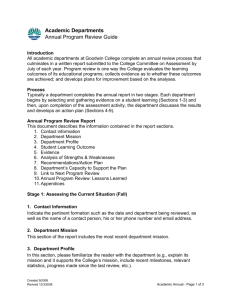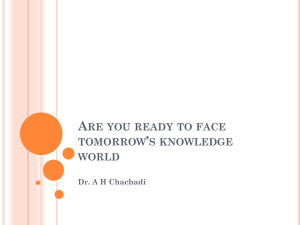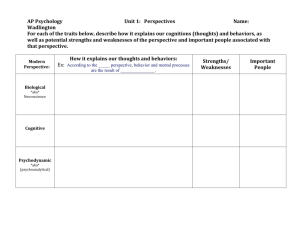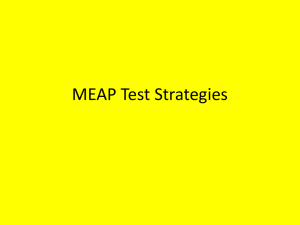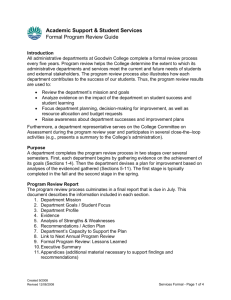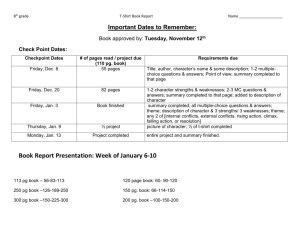The Integrated Curriculum Model (ICM) units are designed to
advertisement
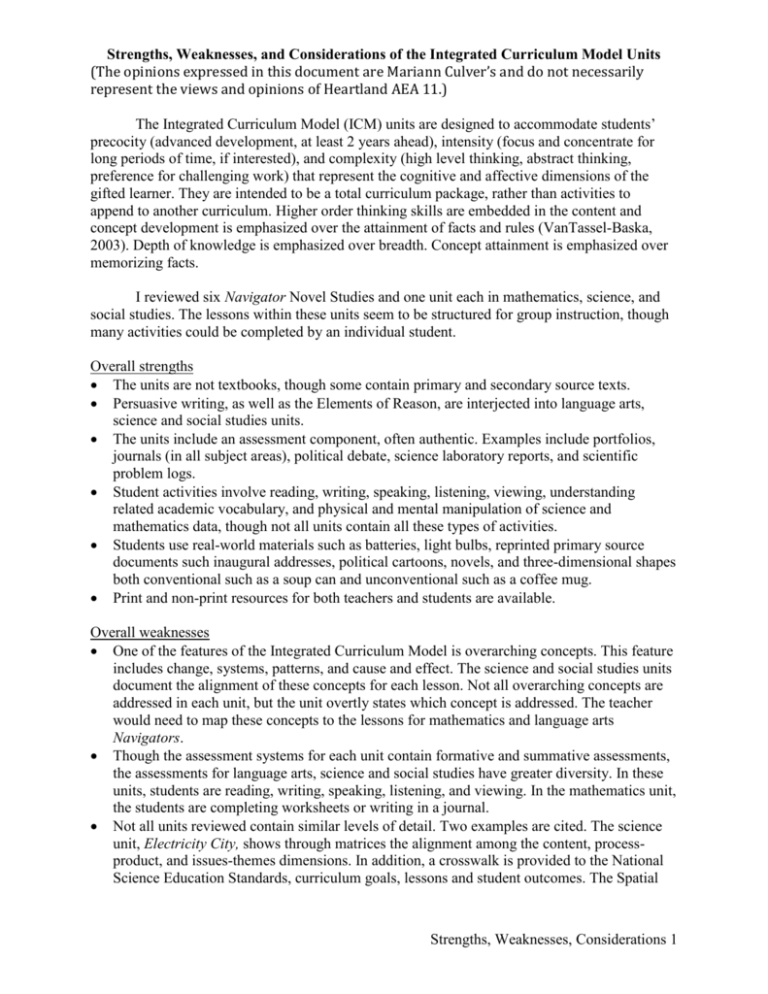
Strengths, Weaknesses, and Considerations of the Integrated Curriculum Model Units (The opinions expressed in this document are Mariann Culver’s and do not necessarily represent the views and opinions of Heartland AEA 11.) The Integrated Curriculum Model (ICM) units are designed to accommodate students’ precocity (advanced development, at least 2 years ahead), intensity (focus and concentrate for long periods of time, if interested), and complexity (high level thinking, abstract thinking, preference for challenging work) that represent the cognitive and affective dimensions of the gifted learner. They are intended to be a total curriculum package, rather than activities to append to another curriculum. Higher order thinking skills are embedded in the content and concept development is emphasized over the attainment of facts and rules (VanTassel-Baska, 2003). Depth of knowledge is emphasized over breadth. Concept attainment is emphasized over memorizing facts. I reviewed six Navigator Novel Studies and one unit each in mathematics, science, and social studies. The lessons within these units seem to be structured for group instruction, though many activities could be completed by an individual student. Overall strengths The units are not textbooks, though some contain primary and secondary source texts. Persuasive writing, as well as the Elements of Reason, are interjected into language arts, science and social studies units. The units include an assessment component, often authentic. Examples include portfolios, journals (in all subject areas), political debate, science laboratory reports, and scientific problem logs. Student activities involve reading, writing, speaking, listening, viewing, understanding related academic vocabulary, and physical and mental manipulation of science and mathematics data, though not all units contain all these types of activities. Students use real-world materials such as batteries, light bulbs, reprinted primary source documents such inaugural addresses, political cartoons, novels, and three-dimensional shapes both conventional such as a soup can and unconventional such as a coffee mug. Print and non-print resources for both teachers and students are available. Overall weaknesses One of the features of the Integrated Curriculum Model is overarching concepts. This feature includes change, systems, patterns, and cause and effect. The science and social studies units document the alignment of these concepts for each lesson. Not all overarching concepts are addressed in each unit, but the unit overtly states which concept is addressed. The teacher would need to map these concepts to the lessons for mathematics and language arts Navigators. Though the assessment systems for each unit contain formative and summative assessments, the assessments for language arts, science and social studies have greater diversity. In these units, students are reading, writing, speaking, listening, and viewing. In the mathematics unit, the students are completing worksheets or writing in a journal. Not all units reviewed contain similar levels of detail. Two examples are cited. The science unit, Electricity City, shows through matrices the alignment among the content, processproduct, and issues-themes dimensions. In addition, a crosswalk is provided to the National Science Education Standards, curriculum goals, lessons and student outcomes. The Spatial Strengths, Weaknesses, Considerations 1 Strengths, Weaknesses, and Considerations of the Integrated Curriculum Model Units (The opinions expressed in this document are Mariann Culver’s and do not necessarily represent the views and opinions of Heartland AEA 11.) Reasoning unit contains none of those elements. The introductions to teachers in the science and social studies units, contain letters to parents explaining the unit of study. If teachers found these valuable, they would need to write their own for the mathematics and language arts Navigators. Language Arts Navigator Novel Study Strengths There are consistent elements in the Navigators: questions during reading, “While You Read…,” “Exploring the Story,” “Meeting the Characters,” “Understanding the Ideas,” and “Connecting to You.” Other consistent activities include using the Literature Web and Vocabulary Web. The persuasive writing activities incorporate interdisciplinary activities and/or research, with at least one connected to nonfiction prompts. In many of the Navigators reviewed, there are creative writing components. Often, there is a concept map activity exploring an idea in the assigned novel, such as hope, imagination, change, etc. Some Navigators have a matrix showing the Navigator goals linked to each activity for the specific novel. For example, the vertebrate/invertebrate report is aligned with the student learning goals, analysis/interpretation skills, written/oral communication, thinking/reasoning skills, and research skills. The suggestions for further reading include texts by the same author and sometimes other authors. The web sites include tools, such as a link to Merriam Webster dictionary, and/or content, such as the Nobel Prize. Weaknesses There are few dramatic interpretations included in the suggested activities, though some activities could be adjusted to include an oral or dramatic component. The citations of resources in each Navigator are not annotated and do not provide teachers with specific reasons to use them. It is simply a listing. Not all web addresses are current. For example, http://www.cynthiarylant.com is no longer active. The Nobel Prize website is active, but not the specific web page cited. Consideration The Navigators are designed for independent or group study. Students who would use the Navigators for independent study would need direct instruction to use the teaching models, such as the Hamburger Persuasive Writing Model, or would need to be proficient in each model’s use. All Navigators reviewed have some of the same activities. For example, the first activities are questions during reading with a consistent structure. The next activities use the Vocabulary Web, Literature Web, and often a concept map. Research papers and persuasive writings are a mainstay, at least for the Navigators reviewed. The Strengths, Weaknesses, Considerations 2 Strengths, Weaknesses, and Considerations of the Integrated Curriculum Model Units (The opinions expressed in this document are Mariann Culver’s and do not necessarily represent the views and opinions of Heartland AEA 11.) repetitiveness of the activities would support students’ independent use, once familiar with the activities. The repetitiveness could elicit a perspective of boredom. Mathematics–Spatial Reasoning, Grades 6-8 Strengths Students have multiple experiences with spatial reasoning: one-dimensional, twodimensional, and three-dimensional within the nine lessons, though two of the lessons are for pre- and post-assessment. Students manipulate mental images, providing them with a high level of abstraction. Concepts are introduced that are used in higher-level course work. For example, recognizing congruent figures and visualizing 3-D structures. The lessons use mathematical vocabulary such as fractal and isometric. Extension activities can be assigned based on student interest/needs, including games, Internet resources, and print resources. Activities are problem-solving and inquiry-based such as writing a Mat Plan for a 3dimensional figure and predicting the shape of a cross-section of an apple with a bite out of it. A Mat Plan is a 2-dimensional image to represent a 3-dimensional figure. Only basic prerequisite knowledge is needed: perimeter, area, volume of a cylinder and cone. The Introduction to the Unit provides suggestions for minimum use to maximum use of the unit. A plan is provided that shows how to use some or all of the lessons. The pre-and post- assessments are parallel, enabling the teacher to calculate growth in student learning. There is one connection to literature, in lesson two, the teacher reads the book, Flatland by Edwin Abbott to the students. Students read the book, A Wrinkle in Time by Madeleine L’Engle, as an extension activity. Weaknesses The overarching concepts identified in the ICM (change, systems, patterns, and cause and effect) are not overtly identified for teachers and not highlighted for students. The presumptions seems to be that teachers and students would be able to deduce this themselves. There are very few real-world applications identified in the activities. One example found in the unit was an explanation of an MRI as two-dimensional shapes to represent a threedimensional organ or body part. But, it is simply an explanation. Students did not use this information in an activity. Not all web addresses are current. For example, http://www.goodnet.com/~setgame/ is no longer active. Consideration The first item on the pre-assessment asks students to draw, given the footprint of a 3dimentional shape, from the top, front, and right side. The fourth item, shows a 3dimensional shape from the side. It is similar to item one. Students who might not Strengths, Weaknesses, Considerations 3 Strengths, Weaknesses, and Considerations of the Integrated Curriculum Model Units (The opinions expressed in this document are Mariann Culver’s and do not necessarily represent the views and opinions of Heartland AEA 11.) otherwise know how to begin to draw the shape for item 1 are provided with a perspective drawing. The introduction to the unit states the pre-assessment is not a readiness test. Thus, the hint that item 4 provides for item 1, which is consistent for the post-assessment, too, needs to be considered as the teacher plans for instruction. Do all students truly understand, or were some able to imitate without understanding? Science–Electricity City, Grades 4-6 Strengths Students learn through a problem-based, real-world scenario. The students are newly hired employees for a local power company. In the scenario, students are part of a team that will be responsible for assuring that electricity requirements are met for a new recreation complex for the community. The teacher support materials within the unit are comprehensive. Four of the five sections to the unit are teacher support materials. For example there are matrices that show the alignment of the content, process-product, and issues-themes dimensions to the National Science Education Standards, curriculum goals, lessons, and student outcomes. In addition, there are implementation guidelines, suggestions for interdisciplinary connections, scoring rubrics, and print/non-print references and resources for both students and teachers. There are five suggestions for adapting the activities to the students’ city, state, etc., such as modifying the problem statement in one lesson so students are designing a recreational complex at a real site in the city or county. Lessons use scientific vocabulary such as circuit, alternating current (AC), hypothesis, etc. The Introduction contains a glossary. Each student documents his/her thoughts about problems and questions posed in each lesson in a Problem Log. Materials used in the activities are real-world, such as batteries, light bulbs, circuit tester, insulated wire, and building blueprints. Cross-curricular suggestions are incorporated such as persuasive writing, converting amps/volts/watts, scale drawing, and the effects of loss of electricity during hurricanes such as Katrina and Rita. A variety of formative assessments, including the Problem Log and completed models, charts, and activities, are available. Suggested rubrics for assessing experimental design process skills, connections to the systems concept, oral presentations and persuasive writing are in one of the appendices. The pre-and post- assessments are parallel, enabling the teacher to calculate growth in student learning. Weaknesses Not all web addresses are current. For example, http://www.codecheck.com/pp_elect.html documents pioneers in the field of electricity. The codecheck.com website is active, but the historical section was not. Strengths, Weaknesses, Considerations 4 Strengths, Weaknesses, and Considerations of the Integrated Curriculum Model Units (The opinions expressed in this document are Mariann Culver’s and do not necessarily represent the views and opinions of Heartland AEA 11.) Considerations The materials used in the activities are real-world, such as batteries, light bulbs, etc. This would require a budget for consumable materials that might not typically be in a school budget. Minimum time to implement the unit is 50 hours. There are no suggestions for shortening the unit. Student books are consumable that contain Problem Log Questions, Student Brainstorming Guides, Experimental Design Diagrams, Student Experiment Protocols, Student Laboratory Reports, Glossary and Laboratory Safety Precautions. It is permissible to copy the blackline masters from the teacher’s guide for a teacher’s classroom. Social Studies–The Road to the White House: Electing the American President, Grades 6-8 Strengths Students participate in a three-part campaign simulation. They assume the roles of members of a campaign team and journalists. The campaign team creates their platform statement and candidate speech, holds a convention with banners, buttons, etc. Journalists write articles, interview candidates, and draw political cartoons. An election is held and inaugural addresses are given. Primary source materials are reprinted for students. For example, articles written after the American Revolution, national platforms from the Democrats and Republicans in 2000, Jimmy Carter’s inaugural address in 1977, Ronald Reagan’s inaugural address in 1981, etc. Lesser known political parties, such as the Libertarian Party and the Green Party, are included in the lesson on political parties. Lessons use social science academic vocabulary such as capitalism, electoral college, inauguration, etc. The Introduction contains a glossary. Learning Centers for students to explore a topic are recommended. A section of the Implementation Guidelines describes four possible centers: political cartoon, writing, computer, and primary source analysis centers. Teaching models are described and graphic organizers provided for concept development, persuasive writing, reasoning about a situation or event, and analyzing primary sources. The pre-and post- assessments are parallel, enabling the teacher to calculate growth in student learning. Weaknesses The unit lacks a rubric for scoring persuasive student writing and scoring guides for the student activities. Some assessments for the activities lack specificity. For example, “participation in groups”, “valid responses to questions”, and “journal response.” Strengths, Weaknesses, Considerations 5 Strengths, Weaknesses, and Considerations of the Integrated Curriculum Model Units (The opinions expressed in this document are Mariann Culver’s and do not necessarily represent the views and opinions of Heartland AEA 11.) Not all web addresses are current. For example, http://www.fec.gov/elections.html contains the results of the 2000 primaries. The www.fec.gov website is active, but the 2000 primaries section is not. Consideration In the letter to the teacher, it is suggested that this unit be augmented with a recent political cartoons; articles relating to recent election processes and candidates; video clips of campaign speeches, debates, and convention events. These resources are not included in the unit’s materials. References VanTassel-Baska, J. (2003). What matters in curriculum for gifted learners: Reflections on theory, research, and practice. In N. Colangelo & G. A. Davis (Eds.), Handbook of gifted education (3rd ed., pp. 174-183). Boston: Allyn and Bacon. Strengths, Weaknesses, Considerations 6

